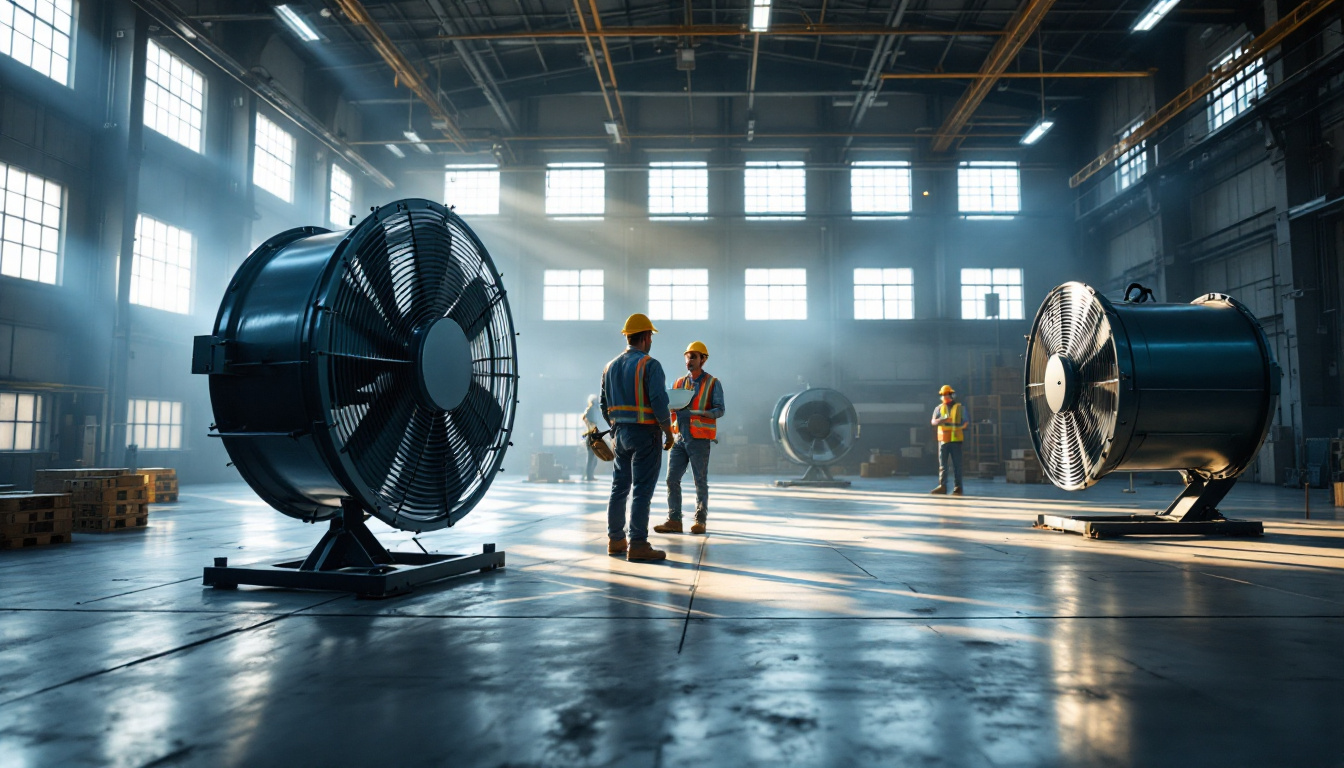
As the demand for efficient and effective warehouse operations continues to grow, lighting contractors play a crucial role in optimizing the work environment. One of the key elements to consider in this endeavor is the integration of big fans into warehouse lighting systems. These fans not only enhance air circulation but also contribute to energy efficiency and overall comfort. This article will explore essential tips for lighting contractors when incorporating big fans into warehouse settings.
Big fans serve multiple purposes in a warehouse environment. Primarily, they help regulate temperature and improve air circulation, which is vital for maintaining a comfortable working atmosphere. In addition, they can significantly reduce energy consumption by allowing for lower thermostat settings, thereby cutting heating and cooling costs.
Moreover, the strategic placement of big fans can complement warehouse lighting systems. Properly illuminated spaces combined with effective air circulation can enhance productivity and safety for workers. Understanding how these two systems interact is essential for lighting contractors aiming to provide comprehensive solutions. The interplay between light and air movement can also influence the overall aesthetic of the warehouse, creating an environment that feels both functional and welcoming.
Furthermore, big fans can play a crucial role in maintaining the integrity of stored products. In warehouses that handle perishable goods or sensitive materials, consistent air circulation helps prevent moisture buildup and temperature fluctuations, which can lead to spoilage or damage. This added layer of protection not only safeguards inventory but also contributes to a more efficient supply chain, as products remain in optimal condition for longer periods.
Integrating big fans with lighting systems offers several advantages. First, the combination can lead to improved energy efficiency. For instance, by using fans to circulate air, warehouses can maintain a comfortable temperature without relying heavily on heating or cooling systems. This synergy can result in substantial energy savings over time.
Additionally, the presence of big fans can enhance the effectiveness of lighting. Bright, well-distributed light can be undermined by stagnant air, which can create hot spots and discomfort. By promoting air movement, fans help maintain an even temperature, allowing lighting systems to perform optimally. This is particularly important in environments where precision is key, such as assembly lines or quality control areas, where visibility can directly impact the quality of work produced.
Moreover, integrating these systems can also lead to a more sustainable warehouse operation. By reducing reliance on traditional heating and cooling methods, businesses can lower their carbon footprint, aligning with modern sustainability goals. This not only appeals to environmentally conscious consumers but can also enhance a company’s reputation in the marketplace, making it more competitive in an increasingly eco-aware economy.
When selecting big fans for a warehouse, several factors should be taken into account. The size of the warehouse is paramount; larger spaces may require multiple fans to ensure adequate air circulation. The type of fan is also crucial—while some fans are designed for high ceilings, others may be more suitable for lower installations.
Another important consideration is the fan’s energy efficiency rating. Opting for fans that are ENERGY STAR certified can lead to significant savings on energy bills, aligning with the overall goal of reducing operational costs. Additionally, noise levels should be evaluated, as quieter fans can contribute to a more pleasant working environment. In bustling warehouses, excessive noise can be distracting and may even affect worker morale, making it essential to choose models that operate quietly while still delivering powerful airflow.
Lastly, the ease of maintenance should not be overlooked. Fans that are designed for easy access and cleaning can save time and resources in the long run, ensuring that the air circulation system remains efficient and effective. Regular maintenance checks can prevent potential breakdowns and extend the lifespan of the fans, ultimately contributing to a more reliable and cost-effective warehouse operation.
Designing a cohesive lighting and fan system requires careful planning and consideration of various elements. Lighting contractors should assess the specific needs of the warehouse, including the type of work being conducted and the layout of the space. This assessment will inform decisions regarding the placement and type of both lighting fixtures and fans.
Moreover, collaboration with warehouse managers and staff can provide valuable insights into the operational challenges faced in the space. Understanding these challenges will enable contractors to tailor their designs to meet the unique requirements of the warehouse environment.
The placement of fans and lights is critical for maximizing their effectiveness. Fans should be positioned to create a consistent airflow throughout the space, while lights should be strategically placed to eliminate shadows and ensure even illumination. A common approach is to install fans in a grid pattern, which can help distribute air evenly across the warehouse floor.
For lighting, a combination of ambient, task, and accent lighting can create a well-rounded system. Ambient lighting provides overall illumination, while task lighting focuses on specific work areas. This layered approach enhances visibility and safety, making it easier for workers to perform their tasks efficiently.
Incorporating smart technology into lighting and fan systems can greatly enhance their functionality. Smart controls allow for the automation of both lighting and fan operations, enabling adjustments based on occupancy and environmental conditions. For instance, fans can be programmed to operate only when the warehouse is occupied, further conserving energy.
Moreover, smart lighting systems can adjust brightness based on natural light levels, ensuring optimal visibility while minimizing energy consumption. These technologies not only improve operational efficiency but also contribute to a more sustainable warehouse environment.
Regular maintenance of both lighting and fan systems is essential for ensuring their longevity and effectiveness. Lighting contractors should establish a maintenance schedule that includes routine inspections, cleaning, and replacements as needed. This proactive approach helps to prevent unexpected failures and maintain a safe working environment.
Safety is another critical aspect of warehouse operations. Properly installed fans should have safety features such as guards to prevent accidents. Additionally, ensuring that fans and lights are installed at appropriate heights can help avoid potential hazards for workers.
Training warehouse staff on the proper use and maintenance of lighting and fan systems is vital. Employees should be educated on how to operate smart controls, adjust settings, and recognize signs of malfunction. This knowledge empowers staff to take an active role in maintaining their work environment, enhancing both safety and efficiency.
Furthermore, providing ongoing training and resources can foster a culture of safety and responsibility within the warehouse. Encouraging workers to report any issues with lighting or fans promptly can help address problems before they escalate, ensuring a safe and productive workspace.
Examining successful case studies can provide valuable insights into the effective integration of big fans with lighting systems in warehouses. Many companies have reported significant improvements in energy efficiency and employee satisfaction after implementing these systems.
For instance, a large distribution center that installed both LED lighting and big ceiling fans saw a reduction in energy costs by over 30%. The combination of bright, efficient lighting and effective air circulation not only improved visibility but also created a more comfortable working environment, leading to increased productivity.
Feedback from warehouse managers regarding the integration of fans and lighting systems has been overwhelmingly positive. Many have noted that the combination has not only enhanced operational efficiency but has also contributed to a more pleasant working atmosphere. Employees report feeling more comfortable and focused, which translates into improved performance.
Moreover, managers have highlighted the importance of having a reliable contractor who understands the unique needs of their warehouse. This collaboration ensures that the systems installed are tailored to the specific requirements of the space, ultimately leading to greater satisfaction and success.
The landscape of warehouse lighting and ventilation is continually evolving. As technology advances, lighting contractors must stay informed about the latest trends and innovations. One significant trend is the increasing focus on sustainability and energy efficiency.
Many warehouses are now seeking to implement renewable energy sources, such as solar power, to supplement their lighting and fan systems. This shift not only reduces reliance on traditional energy sources but also aligns with corporate sustainability goals.
The Internet of Things (IoT) is becoming increasingly relevant in warehouse operations. Smart sensors can monitor environmental conditions, adjusting lighting and fan operations in real-time based on factors such as temperature and occupancy. This level of automation enhances efficiency and ensures optimal working conditions.
Furthermore, IoT technology can provide valuable data analytics, allowing warehouse managers to track energy consumption and identify areas for improvement. This data-driven approach enables informed decision-making, ultimately leading to more effective and sustainable warehouse operations.
Incorporating big fans into warehouse lighting systems presents a unique opportunity for lighting contractors to enhance both energy efficiency and worker comfort. By understanding the interplay between these systems and employing best practices in design, maintenance, and technology integration, contractors can deliver comprehensive solutions that meet the evolving needs of warehouses.
As the industry continues to advance, staying informed about trends and innovations will be essential for lighting contractors. Embracing new technologies and fostering collaboration with warehouse managers will ensure that lighting and fan systems not only meet current demands but also anticipate future challenges.
Ultimately, the goal is to create a safe, efficient, and comfortable working environment that supports the productivity and satisfaction of all warehouse employees. By focusing on these key areas, lighting contractors can play a pivotal role in shaping the future of warehouse operations.
Ready to elevate your warehouse lighting and ventilation projects? Look no further than LumenWholesale for all your big fan and lighting needs. Our extensive selection of spec-grade lighting products is designed to meet the highest industry standards, ensuring you deliver reliable and high-performance solutions to your clients. With unbeatable wholesale prices, free shipping on bulk orders, and no middleman markups, you can trust LumenWholesale to provide the best value in lighting solutions. Enhance your warehouse environments with quality, affordability, and convenience. Explore our products now and discover the LumenWholesale difference.

Explore the fascinating science of Ballard Lights and discover how lighting contractors can leverage this knowledge to enhance their projects.

Discover the essential screw sizes for light fixtures with expert tips from lighting contractors.

Explore the pros and cons of traditional lighting and fan solutions versus modern alternatives.

Discover the cutting-edge strategies lighting contractors use to maximize efficiency and innovation with LED bulbs.